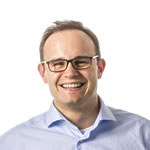About This Webinar
Optical measurements are ideally suited to study the smallest changes in a parameter or a signal of importance to a physical system. This is the case for the minuscule length changes tracked by optical interferometers in gravitational-wave astronomy and for the subtle absorption changes observed with spectroscopic techniques. All such applications share a challenge: After converting the small photonic signal into an electronic one, the latter needs to be captured despite the inevitable overlaid noise floor.
Measurement strategies such as lock-in amplification and boxcar averaging help to average the signal while suppressing spurious noise. To minimize the implementation effort, save precious measurement time, and record high-quality data, it is essential to choose the best approach and settings for a given experiment.
To provide practical guides for different experiments in optics and photonics, this webinar will focus on four techniques with requirements that are typical within the corresponding application area:
- Tunable diode laser absorption spectroscopy (TDLAS), representing linear spectroscopy.
- Pump-probe spectroscopy, as an example of nonlinear and ultrafast techniques.
- Stimulated Raman scattering (SRS) microscopy, standing for all laser scanning imaging applications.
- Carrier-envelope offset (CEO) stabilization, as an example of laser locking methods.
By taking a close look at these techniques, you will learn how to:
- Choose the most suitable measurement scheme, for example, lock-in amplifier or boxcar averager;
- Perform a measurement; and
- Tune your measurement settings to maximize the signal-to-noise ratio.
Who should attend:
Whether you are a researcher, an engineer, or a student who needs to plan or improve an experiment, you will come out of this webinar knowing how to optimize your signal acquisition and minimize the time taken to set up the first measurement. If you work on photocounting experiments or with CCD cameras for data acquisition, you can also expect to gain a number of useful insights.
About the presenter:

Claudius Riek, Ph.D., is an application scientist responsible for all photonics applications at Zurich Instruments, with seven years of experience in ultrafast photonics, in particular THz time-domain spectroscopy, laser scanning microscopy, and frequency combs. Riek is curious to look into new applications way beyond optics and photonics.
About Zurich Instruments:
Zurich Instruments makes lock-in amplifiers, arbitrary waveform generators, impedance analyzers, quantum computing control systems, phase-locked loops, and boxcar averagers. In combination with LabOne, the Zurich Instruments control software, a new benchmark is set for instrumentation in the DC to gigahertz range. This unique approach reduces the complexity of laboratory setups, removes sources of problems, and supports new measurement strategies that enable the progress of research.